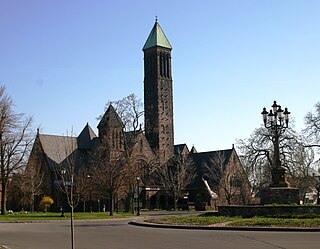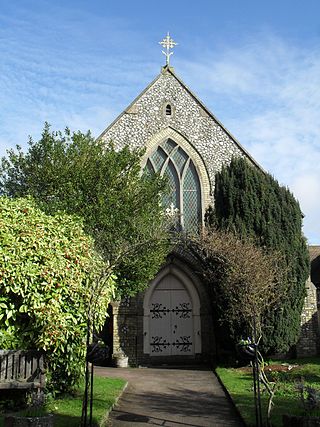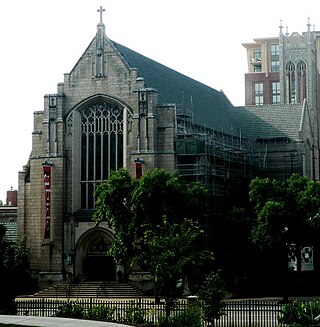
Royton is a town in the Metropolitan Borough of Oldham, Greater Manchester, England, with a population of 21,284 in 2011. Close to the source of the River Irk, near undulating land at the foothills of the South Pennines, it is 2 miles (3.2 km) northwest of Oldham, 3 miles (4.8 km) southeast of Rochdale and 8 miles (12.9 km) northeast of Manchester.

Greyfriars Kirk is a parish church of the Church of Scotland, located in the Old Town of Edinburgh, Scotland. It is surrounded by Greyfriars Kirkyard.

Westwood is an urban area of Oldham, in Greater Manchester, England. It occupies a hillside known as North Moor in the western part of Oldham, close to its boundary with Royton and Chadderton. Westwood, which has no formal boundary or extent, is bisected by the A6048 road.

The Moravian Church of the British Province is part of the worldwide Moravian Church Unity. The Moravian Church in Britain has bishops in apostolic succession.
The Jamaica Province of the Moravian Church is part of the worldwide Moravian Church Unity.

Chowbent Chapel is an active Unitarian place of worship in Atherton, Greater Manchester, England. It was built in 1721 and is the oldest place of worship in the town. It is a member of the General Assembly of Unitarian and Free Christian Churches, the umbrella organisation for British Unitarians. The chapel was granted Grade II* Listed status in 1966.

Bethabara Moravian Church is a congregation of the Jamaica Province of the Moravian Church. It opened for worship on 1841-07-28.

The First Presbyterian Church in Buffalo, New York was the first organized religious body formed in what was then the western frontier of New York State. The town of Buffalo was sparsely populated when the church was organized on February 2, 1812. However, having survived the War of 1812, the town of Buffalo was rebuilt and rapidly grew with the completion of the Erie Canal in 1825. The first two buildings were located on the same downtown lot. However, the congregation relocated between 1889 and 1891 to its present location approximately one and-a-half miles to the north in a more residential area.

Fairfield Moravian Church and its surrounding settlement was founded in 1785 in Fairfield, Droylsden, Lancashire, England. It was founded by Benjamin La Trobe as a centre for evangelistic work for the Moravian Church in the Manchester area. Numbers 15, 28 and 30 Fairfield Square are Grade II* listed buildings.
Wheler Street Moravian Church was founded in 1899 through outreach work from the nearby Fairfield Moravian Settlement. The new church stood at Wheler Street in Higher Openshaw, Manchester, England.
Salem Moravian Church was founded in Oldham, Lancashire, England in 1825 by John Lees. Br Lees, who lived in the Clarksfield area of Oldham, was associated with the Moravian Settlement at Fairfield in Droylsden.
Dukinfield Moravian Church was founded in Dukinfield, Cheshire, England in 1755 following a period of evangelistic work in the area by Moravians from 1742. It now stands within the Tameside Metropolitan Borough, Greater Manchester.

Fulneck Moravian Church and its associated settlement were established on the Fulneck estate, Pudsey, in the West Riding of Yorkshire, England, in 1744 by Count Nicolaus Ludwig von Zinzendorf, a Moravian Bishop and Lutheran priest, following a donation of land by the evangelical Anglican clergyman, Benjamin Ingham. Fulneck is now part of the City of Leeds, West Yorkshire.

Trinity Moravian church houses a congregation of the Jamaican province of the Moravian Church. It was established in 1954 as part of the bicentenary celebrations of the Moravian Church in Jamaica.

Westminster Presbyterian Church of Alexandria, Virginia, U.S. located at the corner of Cameron Mills Road and Monticello Boulevard in the city's North Ridge section. Westminster Presbyterian Church is a member of the Presbyterian Church (U.S.A.), the Mid-Atlantic Synod and the National Capital Presbytery.

Steyning Methodist Church is a Methodist place of worship serving Steyning and surrounding villages in the Horsham district of West Sussex, England. Built for a Wesleyan Methodist congregation who had outgrown an earlier chapel nearby, the Gothic Revival building opened in 1878 and has since been extended. The flint and yellow brick church is set back from Steyning's ancient High Street and is within the village conservation area. It is one of nine churches in the Worthing Methodist Circuit.

Underbank Chapel is a Unitarian place of worship in Stannington, a suburb of Sheffield, South Yorkshire. It is a member of the General Assembly of Unitarian and Free Christian Churches, the umbrella organisation for British Unitarians.

Luther Memorial Church is a Lutheran congregation at 1021 University Avenue in Madison, Wisconsin in the United States. A member of the Evangelical Lutheran Church in America (ELCA), it is known for its worship, music, education, social ministry and preschool programs. The congregation's cathedral-like Neogothic-style building, designed by local architects Claude & Starck and built in 1923, was added to the National Register of Historic Places in 2018.

Allin Congregational Church is an historic United Church of Christ church in Dedham, Massachusetts. It was built in 1818 by conservative breakaway members of Dedham's First Church and Parish in the Greek Revival style.























